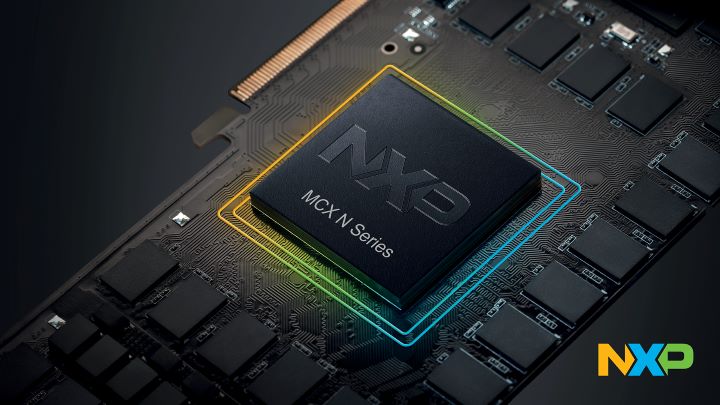The mobile robotics industry is advancing rapidly thanks to technological improvements in sensors and electronics. As engineers
integrate new technologies, all aspects of the mobile robotics ecosystem are evolving. Here's a closer look at some significant
trends driving processing, power, sensors and communication changes.
Edge Processing
Arm® launched the Cortex®-M family 20 years ago and the first microcontrollers hit the market two years later. Arm Cortex-based
microcontrollers continue to push the industry forward with wider capabilities for low-power operation, high performance and
exciting new peripherals.
 NXP’s new MCX N Series MCUs based on Dual Core Arm Cortex-M33
NXP’s new MCX N Series MCUs based on Dual Core Arm Cortex-M33
NXP's latest general-purpose MCUs, the
MCX N series, are cutting edge in mobile
robotics. These microcontrollers bring a neural processing unit (NPU) to the microcontroller level, offering machine learning
(ML) acceleration. The eIQ® Neutron NPU
supports a wide range of neural network types, including CNN, RNN, TCN, transformer networks and more, opening up new
possibilities for the industry.
Edge computing is also seeing continuous improvement as microprocessors such as NXP's new
i.MX 9 series, which also includes an eIQ
Neutron NPU among a wide range of powerful peripherals.
Functional safety
is a major automotive and industrial mobile robotics consideration. Robotic systems can operate more safely with microprocessors
featuring FuSa as a core principle now available.
Dive deeper into NXP solutions that ignite autonomous mobile robots. Learn more in our
training session.
Power
The commercialization of Gallium Nitride (GaN) has profoundly impacted the electronics industry, revolutionizing power
electronics with its ability to deliver higher performance and significantly improved efficiency.
Motor drivers for mobile robots can be built into dramatically smaller volumes with much higher efficiency, resulting in longer
battery life and reduced thermal management requirements.
The advantages of GaN also apply to switched-mode power converters. The rapid turn-on/turn-off speeds of GaN devices allow
higher-frequency power converters allowing engineers to utilize smaller, lower-cost inductors and capacitors.
 Motor Driver Development Kit
Motor Driver Development Kit
Exciting new battery chemistries are hitting the market and entering mass production. While it does not look like Lithium
Polymer batteries will be removed from the top spot when it comes to power density, new battery technology is promising where
this is less of a concern. Sodium-ion batteries may not have the same energy density but rely on far more naturally abundant
metals. While Lithium has an uneven geographic distribution, high cost and high environmental impact, sodium is readily
available in salt water. Sodium-ion batteries do not require cobalt, nickel and copper for chemistries such as NaFeO2, further
reducing cost while increasing material availability. Major battery manufacturers are investing heavily in increasing sodium-ion
battery production capacity, which should result in lower battery costs that, in turn, can reduce the costs of mobile robots
while increasing run times for applications less sensitive to volumetric energy density.
Sensors
Many mobile robotic platforms rely heavily on vision. As mentioned previously, microcontrollers and microprocessors with NPUs
allow real-time inference and classification of images to improve a robot's awareness of its environment.
 Mobile Robotics and Machine Vision
Mobile Robotics and Machine Vision
The incredibly fast pulses possible with GaN devices also allow faster and higher-resolution 3D depth mapping with LiDAR. Robot
navigation can take a major leap forward with advancements in Simultaneous Localization and Mapping (SLAM) algorithms. Once
again, engineers can apply machine learning techniques to the 3D data environment for increased perception and decision-making
capabilities.
As the robot's situational awareness improves, so can its autonomy and capabilities outside tightly controlled environments.
Communication and Connectivity
Communication and connectivity play a crucial role in the advancement of mobile robotics. With the latest developments in
wireless technologies, robots can
now seamlessly communicate with other devices, systems and even humans. Integrating Wi-Fi, Bluetooth and 5G networks enable
remote control, real-time data transmission and over-the-air updates, enhancing mobile robots' flexibility and adaptability.
5G networks, with low latency and high bandwidth, are rapidly being rolled out worldwide. This technology opens up new
possibilities for mobile robotics. Robots can now rely on cloud computing for resource-intensive tasks like complex data
processing and decision-making while maintaining real-time responsiveness.
Mesh networking and swarm robotics are revolutionizing multi-robot collaboration. By establishing ad-hoc networks, robots can
communicate and coordinate with each other, sharing information and tasks to achieve common goals. This capability enables the
deployment of robot swarms in various applications, such as search and rescue, environmental monitoring and large-scale
logistics.
Adopting IoT protocols, such as MQTT and CoAP, further facilitates the integration of mobile robots with other connected devices
and systems.
Gear Up for the Future: Let Mobile Robotics Lead the Way to Exciting Innovations
The mobile robotics industry is experiencing rapid advancements driven by innovations in edge processing, power, sensors and communication technologies. The introduction of neural processing units in microcontrollers and microprocessors, coupled with the rise of GaN devices and new battery chemistries enable more efficient, intelligent and autonomous mobile robots.
Simultaneously, advancements in vision systems, SLAM algorithms and wireless connectivity enhance robots' situational awareness and collaboration capabilities. As these trends continue to shape the industry, we can expect mobile robots to become increasingly versatile, adaptable and integrated into various aspects of our lives, revolutionizing industries and transforming how we live and work.
Learn more about NXP’s mobile robotics solutions and our latest NavQPlus companion computer reference design.




